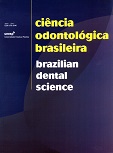Dentistry teachers and the Burnout Syndrome
DOI:
https://doi.org/10.14295/bds.2012.v15i1.729Keywords:
Saúde Ocupacional, Esgotamento Profissional, Odontologia, Professores, Saúde PúblicaAbstract
The Burnout Syndrome is considered a psychosocial problem to which teachers are routinely exposed. This study was conducted to estimate the prevalence of burnout in Dentistry teachers and its relation to relevant socio-demographic variables. The participants were 70 teachers from the undergraduate Dentistry Course, Faculty of Dentistry of Araraquara – UNESP. Oldenburg Burnout Inventory (OLBI) was used. The prevalence of burnout was estimated. In order to compare mean scores of burnout dimensions for each variable of interest Student’s t tests, for a significance level of 5%, were performed. Mean age of participants was 46.0 ± 6.1 and teaching experience was 19.6±7.6 years. The prevalence of burnout was 17.1%. Low mean scores for Exhaustion (2.11±0.61) and Disengagement (1.73±0.50) were observed. There were statistically significant differences in the exhaustion dimension between genders (p=0.049), for participants who reported taking medication due to work (p=0.008) and for those who have thought about quit teaching (p=0.001). There was no statistically significant difference between Exhaustion scores as to teaching experience and also Disengagement scores according to the habit of taking medication, the experience as a teacher and gender.Downloads
Downloads
Published
How to Cite
Issue
Section
License
Brazilian Dental Science uses the Creative Commons (CC-BY 4.0) license, thus preserving the integrity of articles in an open access environment. The journal allows the author to retain publishing rights without restrictions.
=================




























